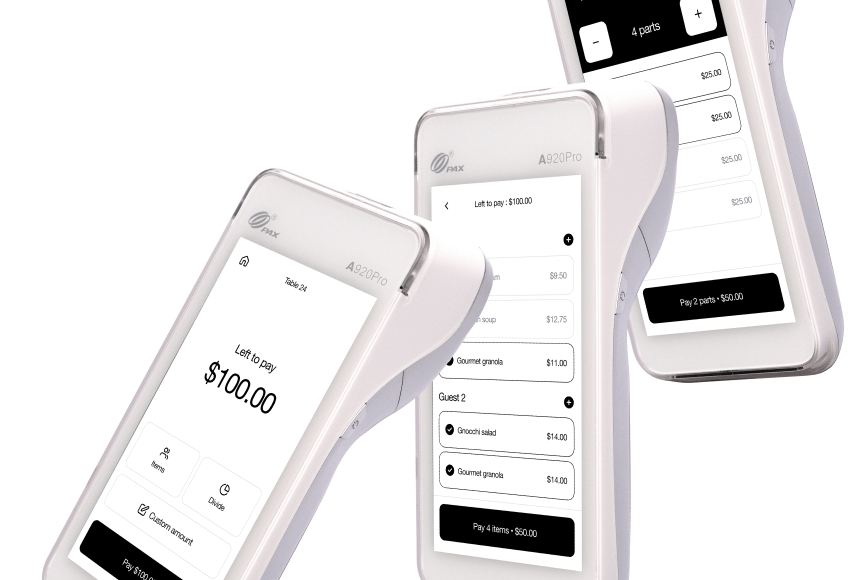
The Ultimate Guide to Choosing the Right Wireless Connectivity for Your Restaurant’s Payment Terminals
When Lightning-Fast Payments Lead to Happier Diners
Have you noticed how impatient people get when they have to wait an extra minute or two to pay for their meal? In a bustling restaurant environment, every second counts. Whether you run a cozy bistro in a small town or a high-end steakhouse in a big city, your guests want a payment process that’s quick, seamless, and hassle-free. That’s why payment terminals rely on strong wireless connectivity to keep transactions flowing at top speed Lien absolu pour une page d’exemple.
These days, card machines aren’t merely functional devices; they are a vital cog in your establishment’s operational engine. Think of them like sous chefs: often overlooked yet indispensable. When your payment device suddenly goes offline, it’s as if your sous chef has walked out right before service. The result? Stressed staff, frustrated guests, and potential losses. With Wi-Fi and 4G now widely available, the big question is: which connectivity option is best for your restaurant’s payment needs?
This article explores why wireless connectivity matters so much, digs into the main differences between Wi-Fi and 4G, and helps you pick the right system for your busy kitchen. We’ll also look at crucial factors like bandwidth, reliability, security, and costs. Consider this a friendly conversation with someone who’s been in the trenches—someone who wants to help you offer your guests the best experience possible, from appetizer to check.
Why Connectivity Is the Unsung Hero of Restaurant Payments
When most people think about a restaurant’s success, they consider the menu, the ambiance, and the service quality. Connectivity is rarely the first thing to come to mind, yet it’s an essential ingredient to delivering excellent customer experiences. One glitch in your payment process can frustrate customers, lower tips, and harm your reputation. Fast, reliable wireless connectivity is what powers not just your credit card terminals, but also additional features like QR code payments, digital receipts, and direct feedback or ratings.
According to a Federal Communications Commission report, the average American now expects instant access to online resources, and that includes quick payment processing. If your network lags, or if customers have to wait too long to settle their bill, they probably won’t rave about your restaurant to their friends. They might recall how slow payments disrupted an otherwise wonderful meal. In short, upgrading your internet connection or investing in a 4G-enabled payment terminal can be as critical as perfecting your signature dish.
Here’s why it matters so much:
- Better Customer Experience: Fewer delays mean happier guests who can pay and go without a hitch.
- Higher Table Turnover: Speedy payments let you seat the next party faster, leading to increased revenue.
- Enhanced Security: Reliable networks help protect transaction data, reducing the risk of fraud or breaches.
- Operational Efficiency: Staff can focus on hospitality, not troubleshooting transaction errors or rebooting machines.
Understanding Wi-Fi: Pros, Cons, and Misconceptions
Many restaurant owners naturally gravitate toward Wi-Fi for card machines. After all, Wi-Fi is relatively simple to set up, you’re likely already paying for it, and it’s a standard part of your restaurant’s digital ecosystem. Let’s delve deeper into Wi-Fi’s strengths and weaknesses to help you determine whether it’s the perfect match for your dining room.
Why Wi-Fi Is a Go-To Choice
Picture your payment terminal as a specialized tablet or a small portable device that operates wirelessly. For that device, Wi-Fi can be an excellent partner:
- Easy Integration: Most restaurants already have a Wi-Fi network for their point-of-sale (POS) systems and staff tablets, making it straightforward to add your payment terminal into the same network.
- Lower Data Costs: Since Wi-Fi traffic relies on your internet plan rather than cellular data, you don’t have to worry about monthly overage fees for your payment terminal usage.
- Stable Speed (if Configured Correctly): A robust Wi-Fi setup with quality hardware, sufficient bandwidth, and well-placed routers can handle multiple transactions instantaneously.
Wi-Fi can work wonders, especially if your IT infrastructure is already strong. For venues where the payment terminal stays in one area—like at a fixed register—Wi-Fi often proves reliable and budget-friendly.
Common Hurdles of Wi-Fi Connectivity
Despite its popularity, Wi-Fi is not without its potential hiccups:
- Signal Interference: A busy kitchen filled with metal appliances and thick walls can interfere with the Wi-Fi signal. Additionally, if many devices are connected simultaneously, bandwidth can get choked.
- Power Outages: If your router or modem loses power, or if your internet service provider (ISP) experiences downtime, you can’t process payments unless you have a backup option.
- Security Concerns: Public or unprotected Wi-Fi networks can expose your business to cyber risks if not configured properly. While you can use password protection and network segmentation, the threat still exists if your security measures are lax.
- Limited Range: Large restaurants or outdoor seating areas may put too much distance between your device and the router, causing spotty connections or disconnections.
Is Wi-Fi Right for Your Establishment?
If you own a small to medium-sized restaurant where the payment terminal sits near a reliable router, Wi-Fi could be your best friend. Just be aware that maintaining robust coverage and putting security measures in place may require some investment. A combination of high-quality routers, repeaters, and regular network maintenance could lessen the likelihood of downtime.
Exploring 4G: The Benefits of Going Cellular
Alternatively, imagine your payment terminal as a cellphone that taps into mobile data networks. When it’s 4G-enabled (or even 5G in some cases), it can connect to the internet without relying on a local router or access point. This approach has steadily gained favor for its portability and reliability—especially for restaurants dealing with thick walls or frequent Wi-Fi dropouts.
Key Advantages of 4G Connectivity
There’s a reason many restaurants, cafés, and food trucks now use 4G. Some of the top perks include:
- Broad Coverage: If there’s cell signal, there’s internet. You automatically bypass the usual headaches of configuring routers or worrying about line-of-sight issues common with Wi-Fi.
- Backup Readiness: Even if your main ISP goes down or a storm knocks out power to the router, your device can still function via its cellular data plan. This is invaluable during peak service times.
- Flexible Mobility: Let’s say you want to use a tableside payment method or operate a pop-up stand. A 4G payment terminal can easily follow you anywhere you have mobile coverage.
- Less Interference: Because 4G uses cellular signals, it avoids the typical interference that microwave ovens, thick walls, or even other Wi-Fi networks might generate.
Potential Drawbacks of 4G
No connectivity method is perfect. Here are the trade-offs with 4G:
- Data Plan Fees: Cellular data services can become costly if you process large volumes of transactions or if your device consumes data for additional features (like real-time analytics, live ordering, etc.).
- Signal Strength Variability: While urban areas generally enjoy robust coverage, rural spots or buildings with thick concrete walls can still suffer from a weak cellular signal.
- Hardware Costs: A 4G-enabled payment terminal may cost more than its Wi-Fi-only counterpart, so there’s a slightly higher initial investment.
Case Study: The Busy Manhattan Eatery That Combined Both
To illustrate the real-life implications, let’s consider “Crust & Crumble,” a pizzeria in Manhattan’s Flatiron District with a steady stream of foot traffic. During peak lunch hours, the line at the counter can stretch out the door, while a separate dining area hosts table service. The restaurant initially relied on a Wi-Fi-only setup and frequently suffered lags when the dining room filled to capacity.
The owners decided to switch to a 4G-enabled device during lunch hours so staff could walk the line, take orders, and let customers pay in advance. Meanwhile, the stationary payment terminal at the register remained on the restaurant’s secure Wi-Fi for everyday transactions. This combination approach provided the following benefits:
- Reduced Wait Times: Customers ordering slices to go paid quickly, freeing up time for the cashier to focus on dine-in services.
- Backup Connectivity: If the Wi-Fi momentarily froze due to heavy usage, the 4G terminals kept the line moving.
- Consistent Customer Experience: Guests noticed fewer delays, and positive reviews about “fast service” soon popped up on online platforms.
The key takeaway? Sometimes a hybrid strategy offers the best of both worlds, blending the cost advantages of Wi-Fi with the reliability of 4G.
Critical Factors to Weigh: Speed, Reliability, Security, and Cost
Selecting between Wi-Fi and 4G isn’t just about convenience—it’s about meeting your restaurant’s specific needs. Let’s break down some core considerations.
Speed: Can You Keep Up with the Rush?
The speed of your connection will influence how quickly payment terminals can communicate with payment processors or integrated technology platforms like inventory or loyalty programs. During peak hours, a fast network can shave off a few seconds per transaction, which adds up to shorter lines and happier guests.
| Connection Type | Typical Speeds (Mbps) | Comments |
|---|---|---|
| Wi-Fi (802.11ac or better) | 100-600+ Mbps | Often sufficient, but can drop in crowded networks |
| 4G LTE | 5-50+ Mbps | Usually enough for payment data; speeds can vary |
While speed matters, remember that payment transactions require far less data than video streaming or large file transfers. Even a stable 4G connection with modest speed can be enough for your card machine, but if your guest Wi-Fi is also streaming music or connecting dozens of devices, Wi-Fi bandwidth might suffer, causing small but noticeable slowdowns.
Reliability: Minimizing Dropped Connections
Everything else is moot if your device can’t stay connected. This is where 4G often shines: it provides a more consistent connection in many scenarios, unless you have poor cell service in your area. Wi-Fi, on the other hand, depends on how well your network is set up, the quality of your internet service, and how many devices compete for bandwidth. Redundancy is another factor—some restaurants maintain a secondary internet provider or a simple 4G hotspot as a backup if their primary connection fails.
Security: Protecting Your Guests and Your Business
Restaurants handle sensitive financial data all day. Whether you choose Wi-Fi or 4G, you need robust security to protect card details and personal information. Here’s how each option measures up:
- Wi-Fi: Your job is to ensure the network is WPA2- or WPA3-protected. Consider segmenting your network so the payment terminal is isolated from your guest Wi-Fi. Regularly update your router firmware to patch known vulnerabilities.
- 4G: Cellular data encryption tends to be secure, but the device itself can be compromised if not updated regularly. Additionally, make sure you abide by PCI DSS (Payment Card Industry Data Security Standard) guidelines regardless of how you connect.
Ultimately, it’s about choosing a connectivity option that aligns with best practices for payment security. If you’re unsure what approach is most secure, consider consulting an IT professional who understands the nuances of restaurant operations.
Cost: Balancing Monthly Fees with Potential Revenue
When you weigh the price tags, consider both immediate and long-term costs. For Wi-Fi, you may pay a set amount to your ISP for a high-speed business internet plan, plus the cost of any extra routers or signal boosters. With 4G, you might pay more for the initial device plus ongoing data subscription fees. If your volume of transactions is high, that data overhead could add up—though many mobile carriers in the US offer business packages tailored to small or medium-sized stores.
From a revenue standpoint, faster and more reliable payment processing often translates into satisfied consumers who are likely to spend more or come back more frequently. A single day of lost sales during a Wi-Fi outage could overshadow a whole month’s worth of cellular data fees. Weighing these factors can help you see where the real value lies.
Tips for Optimizing Your Wireless Setup
No matter what path you choose—Wi-Fi, 4G, or a hybrid arrangement—you can fine-tune your network for maximum efficiency. Here are a few practical steps you can try in your own restaurant:
- Pick the Right Hardware: If you opt for Wi-Fi, invest in a business-grade router that can handle multiple simultaneous connections. If you go 4G, make sure your chosen payment terminal supports the best available cellular bands in your region.
- Position Routers Strategically: For Wi-Fi, put routers or extenders in central, open areas, away from thick walls or large metal surfaces. Sometimes moving a router a few feet can drastically improve signal strength.
- Enable Quality of Service (QoS): If your router supports QoS, you can prioritize payment traffic to ensure quick processing, even if staff are streaming music or uploading large files.
- Routine Speed Tests: Periodically run speed tests during peak hours to identify slowdowns. Performance can change over time, so it’s crucial to know your baseline.
- Enable Automatic Failover: Some routers or payment systems can switch from Wi-Fi to 4G if your primary network goes down. This keeps transactions running smoothly.
- Frequent Software Updates: Keep your devices updated. Software updates often include security patches and performance improvements that help ensure stable and secure payments.
Where sunday Fits into the Equation
One of the trends sweeping the restaurant industry is the use of QR codes to expedite payments, tipping, and even prompts for online reviews. That’s something sunday does particularly well, thanks to an intuitive platform designed specifically for busy restaurants. With sunday, your guests simply scan a QR code to pay—no extra steps, no fuss.
Whether your payment terminal uses Wi-Fi or 4G, sunday can blend seamlessly into your workflow, providing a modern payment avenue that meets customers’ growing preference for digital solutions. Speedy payments powered by either Wi-Fi or cellular data not only reduce wait times but also encourage guests to leave a tip or complete a Google review before they’ve even left the table. It’s about making the entire payment process feel like the sweetest part of the meal—a quick treat instead of a tedious chore.
Real-World Approaches to Adopting Wi-Fi or 4G
Every restaurant is different, and there’s no one-size-fits-all formula for selecting connectivity. However, here are some common approaches among US restaurant owners:
- The Single Wi-Fi Network: Best for smaller, single-floor establishments with reliable internet service. Simple, affordable, and easy to maintain.
- Multiple Wi-Fi Routers: Ideal for larger spaces or multi-level restaurants. Proper router placement is crucial, and staff should perform routine checkups.
- Exclusive 4G Terminals: A solid option for pop-up stalls, food trucks, or rotating vendor spaces where wired internet is unavailable. Also a great backup if your primary network is susceptible to outages.
- Hybrid Setup: A combination of Wi-Fi terminals in the main dining area and 4G-enabled terminals for outdoor patios, private event rooms, or high-volume lines. Provides maximum flexibility and redundancy.
Embracing the Wireless Frontier: Finding Your Best Path Forward
By now, it should be clear that your choice between Wi-Fi and 4G hinges on the unique conditions of your restaurant. If your building’s structure or traffic patterns cause frequent Wi-Fi dropouts, a 4G device can save you time, money, and headaches. If your restaurant is small and your internet provider guarantees robust service, secure Wi-Fi might be all you need.
Whichever option you choose, remember that reliable connectivity allows you to be more than just a good restaurateur—it lets you be a great host, too. By accelerating transactions and eliminating frustrating payment delays, you give guests a final taste of efficiency and convenience, ensuring they leave on a high note. That’s a win-win for you and your patrons, covering everything from stronger relationships to better online reviews.
Common Questions About Wireless Connectivity for Card Machines
Does a 4G-enabled card machine use a lot of data?
Typically, payment transmissions consume minimal data. Even high-volume restaurants rarely exceed a few gigabytes per month for purely payment-related activities. However, if the device also processes other data (like real-time analytics dashboards), usage can increase. Many mobile carriers offer tailor-made business plans that fit your volume.
Is Wi-Fi too risky from a security standpoint?
Not if it’s set up properly. A separate, password-protected Wi-Fi network for payments, distinct from your guest network, is a common best practice. Always use strong encryption (e.g., WPA2 or WPA3) and regularly update your hardware’s firmware. If you follow PCI DSS guidelines, Wi-Fi can be very secure.
Which option is faster for card machines: Wi-Fi or 4G?
In most urban and suburban US locations, both Wi-Fi and 4G networks are sufficiently fast to handle payment transactions. Wi-Fi usually has a higher maximum throughput, but 4G’s average speeds are more than adequate for payment data. Your real concern should be overall reliability rather than pure speed.
Should a restaurant invest in a backup connection?
Yes, if you can afford it. Downtime means lost sales and disgruntled guests. Many restaurants choose either a secondary ISP or keep a 4G hotspot on hand for emergencies. This small investment can save a lot of stress during peak hours, especially in areas prone to service interruptions.
Will 5G make 4G obsolete for card machines?
Not anytime soon. While 5G offers faster speeds and lower latency, 4G remains widely accessible and robust enough to process payments. Many areas still lack comprehensive 5G coverage, so 4G devices will remain relevant for quite some time.



